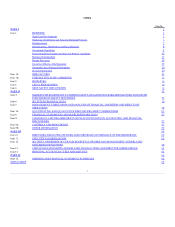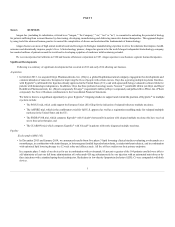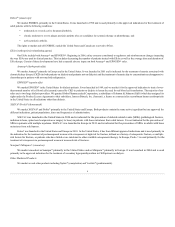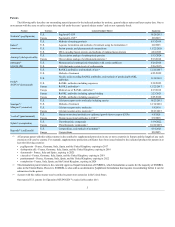Amgen 2013 Annual Report Download - page 3
Download and view the complete annual report
Please find page 3 of the 2013 Amgen annual report below. You can navigate through the pages in the report by either clicking on the pages listed below, or by using the keyword search tool below to find specific information within the annual report.
treatment of metastatic melanoma.
Relapsed/refractory acute lymphoblastic
leukemia (ALL) is a rare and potentially fatal form
of leukemia; many diagnosed with ALL won’t live
more than five years. Blinatumomab is an
antibody that is designed to target and destroy
the cancer cells in those suffering from ALL by
using the body’s own T cells. We are hopeful that
this technology, known as a bispecific T-cell
engager (BiTE®) antibody, could have other
applications for patients suffering from
serious illnesses.
Gastric cancer is another common cancer.
The prognosis to live five years or more with
this illness is often poor. We hope to be able
to help in the fight against gastric cancer via
our human monoclonal antibody rilotumumab,
a personalized, targeted medicine.
Multiple myeloma is a cancer of the plasma cells
that impacts many thousands of people globally.
Kyprolis®, a proteasome inhibitor, represents an
important new option for patients, and we look
forward to reaching many more patients around
the world in 2014 with this innovative medicine.
Recurrent ovarian cancer is one of the deadliest
of gynecologic cancers and the fifth-leading
cause of cancer-related death among women.
We believe trebananib may have the potential
to help women with this disease.
Additional Unmet Medical Needs
We are advancing three additional later-stage
investigational medicines for the treatment of
psoriasis, postmenopausal osteoporosis and
secondary hyperparathyroidism.
There are serious struggles for patients with
psoriasis. Our hope is that brodalumab, an IL-17
receptor antibody, has the potential to deliver
high levels of skin clearance for many patients.
Currently, products like Prolia® are helping stop
bone loss in patients with osteoporosis at high
risk for fracture. With romosozumab, we have
the potential not just to stop bone loss but also
to build bone, making this a possible treatment
option for women with postmenopausal
osteoporosis.
We are also investigating a new option for
patients in the treatment of secondary
hyperparathyroidism with velcalcetide
(AMG 416). Velcalcetide is a peptide designed
to mimic the effects of ionized calcium by
activating the calcium-sensing receptor.
Advancing Biosimilars
In addition to the progress we are making with
the 10 innovative molecules in our pipeline, we
made real progress with our biosimilars program
in 2013. By year-end, three pivotal biosimilar
studies were under way for our Avastin®,
Herceptin® and Humira® biosimilars; and
we are progressing toward pivotal trials for the
remaining three biosimilar programs. We expect
to launch our biosimilars portfolio beginning
in 2017.
Biologics Manufacturing Facility in Singapore
We broke ground in Singapore in early 2013 on
a facility that will enable us to be faster, more
flexible and more efficient in our manufacturing
operations. Amgen is widely recognized as
a leader in biologics manufacturing, and we
continue to advance our capabilities in this field.
An Exciting Year Ahead
2014 will be an exciting year for Amgen. By the
end of the year, we expect to have potentially
pivotal—or registration-enabling—data
from eight of our innovative molecules: two
cardiovascular medicines, four oncology
medicines, one anti-inflammation medicine and
one medicine for secondary hyperparathyroidism.
We will progress in development and
implementation activities around drug delivery
systems. And we will build on the progress
we made in global expansion to more than
75 markets. In addition, we believe the currently
approved indications for XGEVA® and Prolia®
represent significant commercial opportunities.
We anticipate longer-term growth through the
successful development of our later-stage
pipeline, continued expansion into emerging
markets, strategic business development
opportunities and biosimilar opportunities.
Furthermore, our continued focus on increasing
cost efficiencies will assist in providing the
necessary resources to fund many of these
future opportunities.
I would like to thank all of my Amgen colleagues
for delivering for our shareholders and for
patients in 2013. As I look to the future, I am
confident that our strategy is sound, our staff is
aligned and our culture—rooted in science and
innovation—is well grounded. This new era of
biotechnology we are entering will enable us
to reach more patients suffering from serious
illnesses in more markets around the world.
Robert A. Bradway
Chairman and Chief Executive Officer
















